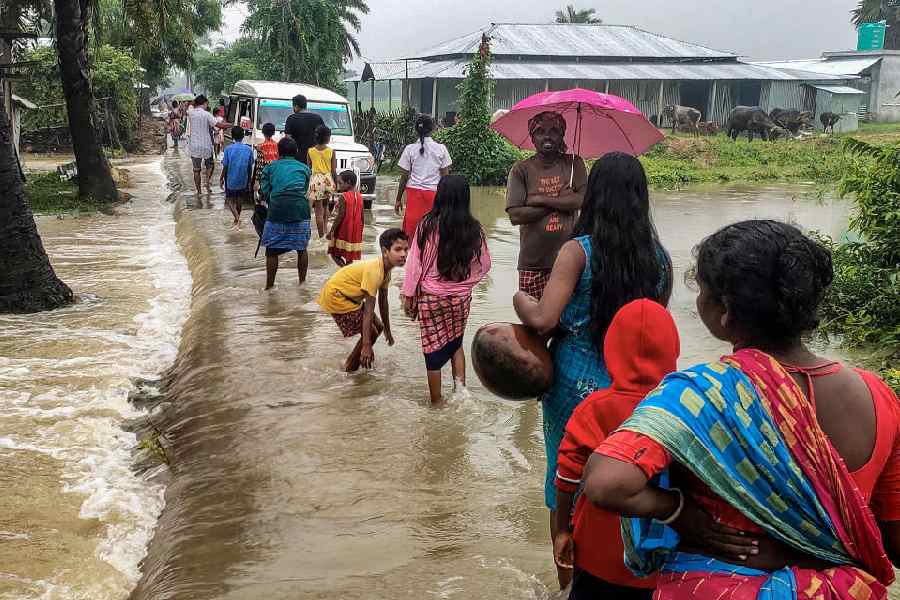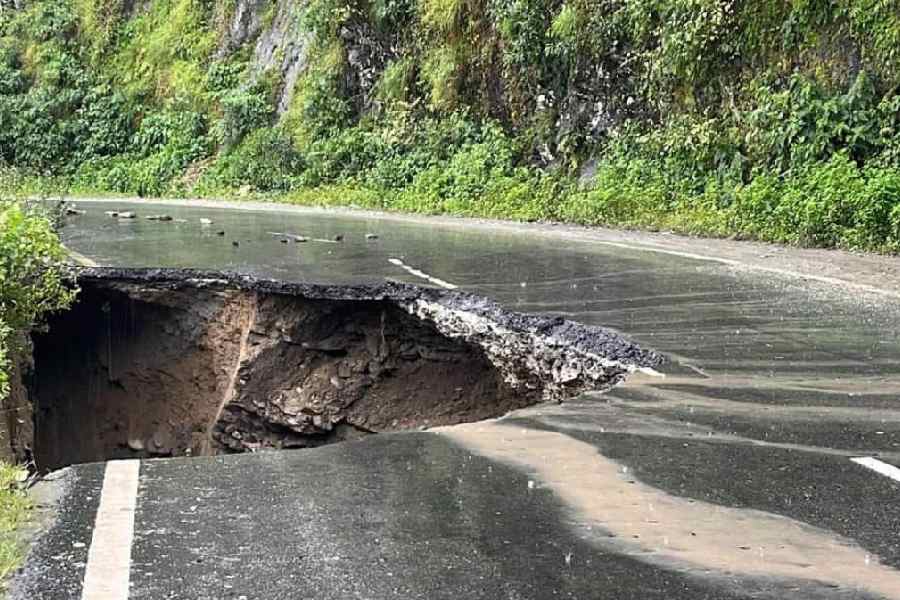Incessant monsoon rain over the past 48 hours eroded away a portion of the NH10, the main highway that connects the Himalayan state of Sikkim and Kalimpong district with Siliguri and the rest of the country, on Sunday morning, snapping direct connectivity with these hilly areas.
The cave-in prompted the police and the administration to announce a halt in traffic along the stretch at Swetijhora, which is around 35km from here. Vehicles bound for Siliguri from Sikkim and Kalimpong and vice-versa are taking turnaround routes now. Officials of the state PWD have said that it would take at least 48 hours to resume traffic on the stretch.
The downpour also led to inundation in districts like Malda, Jalpaiguri and Cooch Behar. Thousands of people faced inconveniences as roads, several localities and important establishments like the Malda Medical College and Hospital got waterlogged.
“Around 7am on Sunday, around 15-metres of NH10 caved in at Swetijhora. The bitumen cover and the earth below fell on the Teesta and created a crater. Initially, a few people managed to pass the spot on two-wheelers, but we stopped the movement of all vehicles through the affected area. The restoration work has started but considering the inclement weather (rain is continuing), it will take at least 48 hours to resume vehicular movement on the damaged stretch of the highway,” said an official of state PWD (NH-X division).
The NH10, which connects Sevoke with Gangtok, is considered the lifeline of Kalimpong and Sikkim. It is also important in terms of security as defence forces move on this road to Sikkim on the India-China border.
With traffic movement coming to a halt along Swetijhora, which is on the Sevoke-Teesta Bazaar route, vehicles are taking detours via Teesta and Kurseong to Siliguri.
“Another diversion is via Sangsey to Lava, Gorubathan and Coronation Bridge. The heavy vehicles will have to take the Chitrey Fatak-Kalimpong town-Lava-Gorubathan Road and Coronation Bridge and can move only in evening hours,” said a source.
On June 23 this year, a similar cave-in happened at Birikdara, another location on the highway.
In Malda district, the southwest monsoon caused heavy rain on Saturday and Sunday.
In Malda town, municipal markets got inundated. The MMCH premises got waterlogged and rainwater flooded some wards of the referral hospital, causing inconvenience to patients and their attendants.

Residents wade through a flooded road in Malda on Sunday
The rainfall also caused waterlogging on both NH12 and NH81, two principal national highways of the district. On NH12, movement of vehicles on one of the two lanes at Adina in Gazole block was suspended for hours. The NH81 too was underwater in many places.
In Gazole, where it rained around 278.6mm in the past 24 hours (till 8.30am on Sunday), the panchayat office in Shahzadpur was under five feet of water. In Malda, it rained 135mm, said weathermen.
A similar situation was witnessed in Jalpaiguri, where it rained 112.5mm. A number of low-lying areas of the town faced waterlogging, and rainwater entered a number of houses. Local markets virtually remained closed.

The fruit market in Englishbazar municipality bore the brunt of the downpour Soumya De Sarkar
The rainfall also led to a rise in the water levels of rivers. Sources in the state irrigation department said they issued a yellow (primary) alert in unprotected areas on both banks of the Teesta from Domohoni (in Mainaguri) to Mekhliganj (in neighbouring Cooch Behar) where the river enters Bangladesh.
In Cooch Behar town, waterlogging was also reported in a number of areas.
Sources in the regional Met office in Calcutta said the monsoon is vigorous over Bihar, Sikkim, and sub-Himalayan Bengal. It rained 180mm in Raiganj, 100mm in Siliguri and 70mm in Darjeeling in the last 24 hours till 8.30am on Sunday.
“The weather is likely to be the same for the next few days, There is a chance of heavy to very heavy rainfall in sub-Himalayan Bengal and Sikkim,” said a weatherman.










